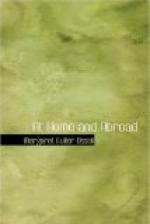These are men who need no flourish of trumpets to announce their coming,—no band of martial music upon their steps,—no obsequious nobles in their train. They are the true kings, the theocratic kings, the judges in Israel. The hearts of men make music at their approach; the mind of the age is the historian of their passage; and only men of destiny like themselves shall be permitted to write their eulogies, or fill their vacant seats.
Wherever there is a genius like his own, a germ of the finest fruit still hidden beneath the soil, the “Chante pauvre petit” of Beranger shall strike, like a sunbeam, and give it force to emerge, and wherever there is the true Crusade,—for the spirit, not the tomb of Christ,—shall be felt an echo of the “Que tes armes soient benis jeune soldat” of La Mennais.
LETTER XI.
FRANCE AND HER ARTISTIC EXCELLENCE.—THE
PICTURES OF HORACE
VERNET.—DE LA ROCHE.—LEOPOLD
ROBERT.—CONTRAST BETWEEN THE FRENCH
AND ENGLISH SCHOOLS OF ART.—THE GENERAL
APPRECIATION OF TURNER’S
PICTURES.—BOTANICAL MODELS IN WAX.—MUSIC.—THE
OPERA.—DUPREZ.—
LABLACHE.—RONCONI.—GRISI.—PERSIANA.—“SEMIRAMIDE”
AS PERFORMED BY
THE NEW YORK AND PARIS OPERAS.—MARIO.—COLETTI.—GARDINI.—
“DON GIOVANNI.”—THE WRITER’S
TRIAL OF THE “LETHEON.”—ITS
EFFECTS.
It needs not to speak in this cursory manner of the treasures of Art, pictures, sculptures, engravings, and the other riches which France lays open so freely to the stranger in her Musees. Any examination worth writing of such objects, or account of the thoughts they inspire, demands a place by itself, and an ample field in which to expatiate. The American, first introduced to some good pictures by the truly great geniuses of the religious period in Art, must, if capable at all of mental approximation to the life therein embodied, be too deeply affected, too full of thoughts, to be in haste to say anything, and for me, I bide my time.
No such great crisis, however, is to be apprehended from acquaintance with the productions of the modern French school. They are, indeed, full of talent and of vigor, but also melodramatic and exaggerated to a degree that seems to give the nightmare passage through the fresh and cheerful day. They sound no depth of soul, and are marked with the signet of a degenerate age.




